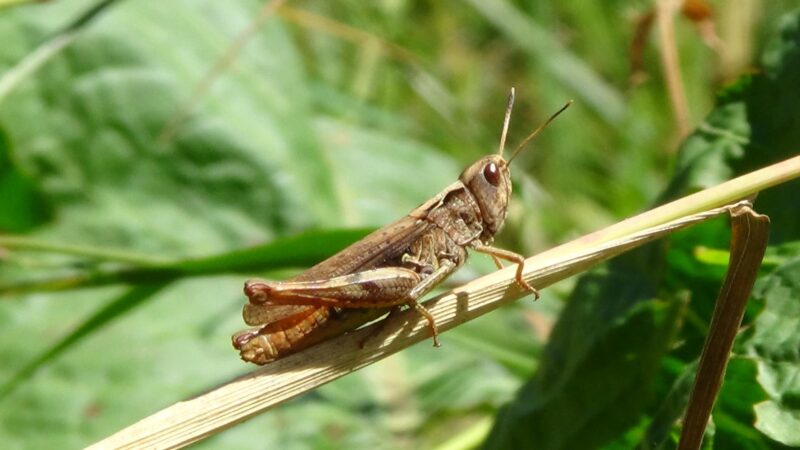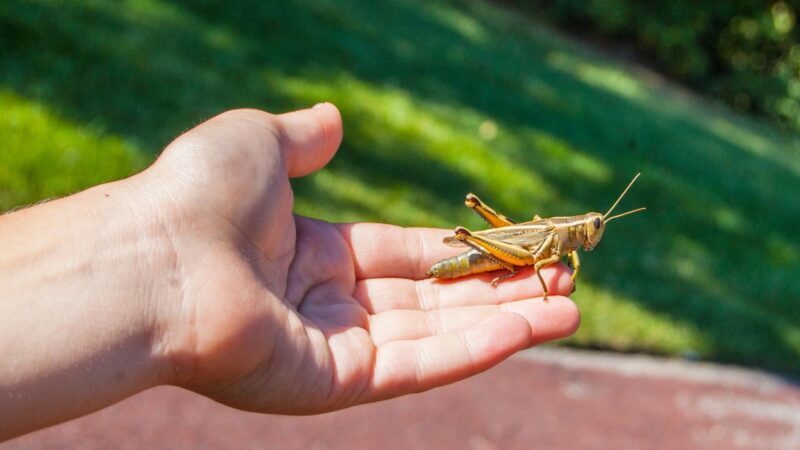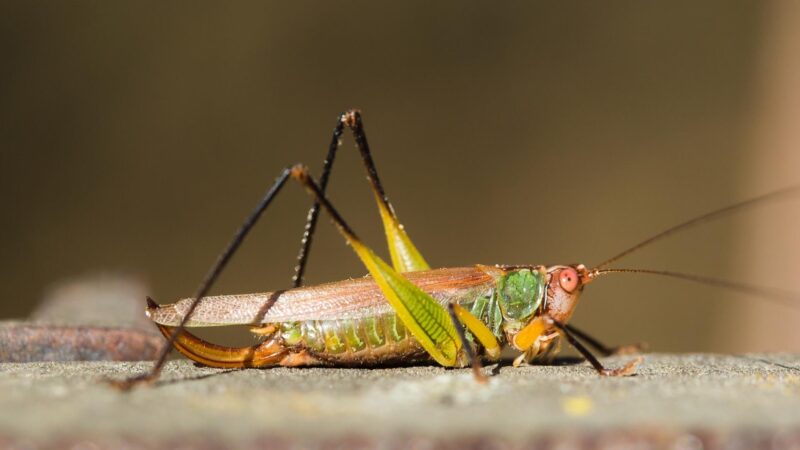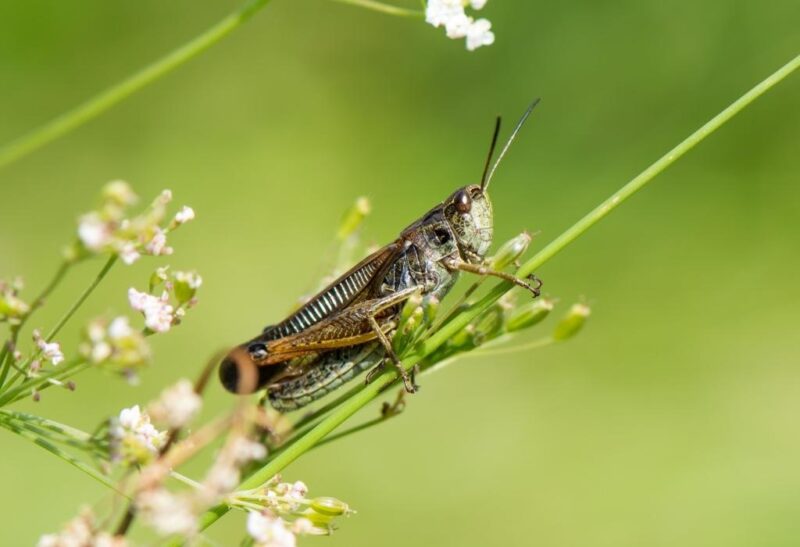Grasshoppers are among the most common insects around the world. As long as there’s grass in the area, expect to find a few grasshoppers happily hopping about.
Curiously, have you ever wondered if these tiny insects are capable of biting humans? And if they did, are their bites harmful? Read on to know the answers.
Grasshoppers are capable of biting. These tiny insects have mouthparts with mandibles that help them cut and chew their food. They also use their mandibles secondarily to bite and attack their enemies.
There’s still so much more to learn about grasshoppers. Since they are capable of attacking their enemies, will they attack humans? Are their bites painful and harmful? Continue reading because this article has all the answers.
Table of Contents
What Do Grasshoppers Look Like?

Grasshoppers are tiny insects that can grow between half an inch to around 2 inches, depending on the species. They have long and slender bodies divided into three body regions. They have large eyes, a mouthpiece with mandibles for chewing, and a pair of antennae on their heads. Also, they have three pairs of legs – with the hind legs, especially larger and longer to help them hop higher.
As for their color, grasshoppers can either be green, brown, or a combination of both. This is to help them camouflage with their surroundings.
Also, grasshoppers have a pair of membranous wings. Despite being known for their impressive hopping, grasshoppers are also strong flyers, although they are rarely seen flying.
Do Grasshoppers Swim?
Grasshoppers do not generally swim. They have bodies that allow them to hop high and fly, but these do not make them capable of swimming.
However, grasshoppers belonging to the Paulinidae family are known to thrive near water sources. These grasshoppers often float and hop on vegetation growing over bodies of water. Also, they have been observed to skate on the water – with some even claiming that these insects are capable of swimming.
Do Grasshoppers Sleep?
Grasshoppers do sleep. Like most living species, grasshoppers also need time to rest after a long day of grazing.
However, they do not sleep for long periods like other animals – they only take long naps during the night. In between their nightly naps, they also find the time to look for food.
How Long Does a Grasshopper Live?
Grasshoppers have a lifespan of around 12 months. This includes their three life stages, namely the egg, the nymph, and the adult grasshopper.
A grasshopper egg takes between three to four weeks before they hatch. The young grasshopper stage, otherwise known as the nymph stage, often lasts for about 10 weeks before it becomes an adult. Then, the adult lives for around 11 weeks to six months.
What Attracts Grasshoppers?

Like most insects and animals, grasshoppers are attracted to places where their food sources are abundant. With that said, grasshoppers are attracted to gardens or farms where grass and crops like corn, alfalfa, and grains are planted.
What Do Grasshoppers Eat?
Grasshoppers are herbivores, so they survive on a plant-based diet. Their primary food source is grass, but they are also observed to munch on the leaves of crops like corn and alfalfa. They also feed on seeds and grains if no other food is available.
What Do Grasshoppers Drink?
Like most living creatures, grasshoppers also need to stay hydrated. Most of the time, they derive their water from the moisture content of plants. But on rare occasions when they do not get enough water from plants, they stay hydrated by drinking from whatever water sources are available.
Do Grasshoppers Bite Humans?

Grasshoppers are capable of biting humans. While they are generally docile towards humans, they will bite when they feel like they’re being attacked.
Fortunately, grasshopper bites are not dangerous. While their bites may sting and cause bleeding, grasshoppers are not venomous insects, so their bite won’t trigger allergic reactions.
Do Grasshoppers Have Teeth?
Grasshoppers have mandibles that serve the purpose of having teeth. These paired jaws are strong enough to help grasshoppers tear through tough vegetation. Its primary purpose is to help grasshoppers eat.
Aside from chewing food, these mandibles are also used by grasshoppers for attacking enemies or as a defense mechanism.
What to Do if Bitten by a Grasshopper?
While grasshopper bites are not as bad as bee stings, they can also cause pain and swelling on the bite site. In case you have been bitten by a grasshopper, you should do the following to avoid an infection:
- Clean the affected area. To keep the bite wound from becoming infected, you should clean it with soap and water as soon as possible.
- Use an ice pack to reduce the swelling. In case the bite site starts to swell, you can use an ice pack to keep the area from swelling further. The ice pack will also numb the pain from the bite.
- Take over-the-counter pain medication. On rare occasions when the bite wound becomes too painful, you can take over-the-counter medication to make the pain more manageable.
Are Grasshoppers Poisonous?

Grasshoppers are not poisonous. They do not have venom sacs that can produce and inject venom whenever they bite their enemies.
Also, grasshoppers are among the few insects that are considered edible. In fact, some grasshopper species are bred for being a favorite snack in some parts of the world. This strengthens the fact that grasshoppers are not poisonous.
Do Grasshoppers Carry Diseases?
Grasshoppers do not usually carry diseases. As living creatures, grasshoppers are not immune to carrying viruses, bacteria, and other pathogens. They are also known to be hosts to parasites like horsehair worms.
Fortunately, these microorganisms do not always affect humans. These cannot be transferred when you touch a grasshopper or when you are bitten by one.
Interestingly, even edible grasshoppers, if infected, do not transfer said microorganisms to humans. That is, as long as the grasshoppers are thoroughly cooked.
Do Grasshoppers Spit?

Grasshoppers do spit. This is part of their defense mechanism when they’re trying to avoid predators.
Studies show that grasshoppers produce a dark liquid substance whenever they feel harassed. Otherwise known as tobacco spit, this substance is a mixture of saliva, digestive enzymes, and chewed-up food and is, therefore, putrid and acidic. Its smell and appearance are enough to drive its potential predators away.
How to Get Rid of Grasshoppers?
Spray a mixture of garlic and water. Grasshoppers hate the strong smell of garlic. To use it to get rid of grasshoppers, simply mince or grind the garlic and mix it with water.
Then, use this mixture to spray on plants and crops that are frequented by grasshoppers. The pungent aroma from this mixture will surely get rid of grasshoppers and keep them from coming back.
Sprinkle flour over your garden. When mixed with the grasshopper’s saliva, the flour-saliva mixture becomes a sticky substance that can glue a grasshopper’s mouthparts shut. This will cause them to flee to look for ways to get rid of it – otherwise, they will starve to death.
Consider getting a pet that’s a known predator of grasshoppers. Grasshoppers are at the bottom of the food chain, so they’re usually more prey than predator. With that said, most grasshopper eaters can be domesticated, such as chickens and ducks. These birds love to graze and will surely offer free pest control for your garden.
Alternatively, if you don’t want the responsibility of having pets, you can install a bird bath in your garden to attract wild birds – so they will be the ones to hunt and prey on the grasshoppers.
To conclude, grasshoppers are generally docile insects. They are busy going about their day feeding on grass and other vegetation – and they will not bother to bite or attack humans out of spite. However, when they do feel threatened, they will not hesitate to use their strong mandibles and attack. With that said, it’s best to leave a grasshopper alone the next time you see one.
List of Sources
Umbers, K. D. L., et al. (2012). Ferocious Fighting between Male Grasshoppers. PLoS One.
Questions and Answers about Caterpillars and Grasshoppers. (2014). PennState Extension.
Alston, D. (2015). Ask a Specialist: Controlling Grasshoppers in the Yard and Garden. Utah State University Extension.
Hammond, G. Acrididae. Animal Diversity Web.
Reyes-Herrera, A., et al. (2022). Changes in the Chemical Composition of Edible Grasshoppers (Sphenarium Purpurascens) Fed Exclusively with Soy Sprouts or Maize Leaves. Insects.
